Related Research Articles

A streamliner is a vehicle incorporating streamlining in a shape providing reduced air resistance. The term is applied to high-speed railway trainsets of the 1930s to 1950s, and to their successor "bullet trains". Less commonly, the term is applied to fully faired upright and recumbent bicycles. As part of the Streamline Moderne trend, the term was applied to passenger cars, trucks, and other types of light-, medium-, or heavy-duty vehicles, but now vehicle streamlining is so prevalent that it is not an outstanding characteristic. In land speed racing, it is a term applied to the long, slender, custom built, high-speed vehicles with enclosed wheels.
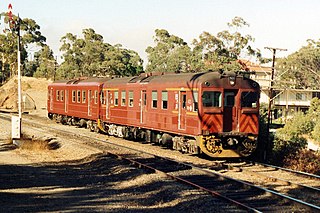
Redhen railcar was the nickname given to the 300 and 400 classes of diesel-hydraulic railcars designed and built by the South Australian Railways’ Islington Railway Workshops between 1955 and 1971. The class remained in service until 1996 and remain a nostalgic part of South Australian culture; some are operated by the SteamRanger Heritage Railway and other railway preservation entities.

The Indian locomotive class WDM-2 is a class of diesel-electric locomotive that was developed in 1962 by American Locomotive Company (ALCO) for Indian Railways. The model name stands for broad gauge (W), Diesel (D), Mixed traffic (M) engine, 2nd generation (2). They entered service in 1962. A total of more than 2,700 WDM-2 was built at ALCO and Banaras Locomotive Works, Varanasi between 1962 and 1998, which made them the most numerous class of mainline diesel locomotive until its successor the WDM-3A.

The Sri Lanka Railway Department is Sri Lanka's railway owner and primary operator. As part of the Sri Lankan government, it is overseen by the Ministry of Transport. Founded in 1858 as the Ceylon Government Railway, it operates the nation's railways and links Colombo with other population centres and tourist destinations.
Under the Whyte notation for the classification of steam locomotives by wheel arrangement, 2-4-0+0-4-2 is an articulated locomotive, usually of the Garratt type. The wheel arrangement is effectively two 2-4-0 locomotives operating back to back, with the boiler and cab suspended between the two power units. Each power unit has two leading wheels on one axle, four powered and coupled driving wheels on two axles and no trailing wheels. A similar wheel arrangement exists for Mallet locomotives, but is referred to as 2-4-4-2.

The Rameswaram Express, previously known as the Boat Mail or Indo-Ceylon Express, is an express train that connects Rameswaram with the state capital Chennai via Tambaram, Chengalpet, Melmaruvattur, Viluppuram, Cuddalore port, Chidambaram, Sirkazhi, Mayiladuthurai, Tanjore, Trichy, Pudukkottai, Karaikudi, Sivagangai, Manamadurai and Ramanathapuram. During the 1900's, it was a combined train and steamer ferry service between India and Ceylon. Connecting Chennai and Colombo, the system initially utilised a rail-to-sea operation, but changed to a rail-to-sea-to-rail operation. Passengers could buy a single ticket for the journey. Now, it runs from Chennai Egmore to Rameswaram via Villuppuram, Kumbakonam, Trichy, Pudukkottai, Karaikkudi, Devakottai, Manamadurai, Paramakkudi, Ramanathapuram, Mandapam and Pamban.
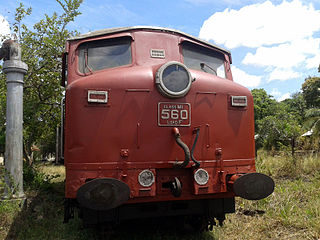
The M1 locomotive was a class of locomotives, used by Sri Lanka Railways, imported from 1953, and manufactured by Brush Bagnall Traction.

Bamunusinghearachchige Don Rampala, was a chief mechanical engineer and later general manager of Sri Lanka Railways. He was the first native Sri Lankan to hold the post of chief mechanical engineer. In 1956, the Institution of Locomotive Engineers in London recognised Rampala as the finest diesel engineer in Asia at the time.

Locomotives and train sets of Sri Lanka Railways consist mostly of diesel locomotives and multiple units. Steam locomotives are no longer used, except on heritage trains, such as the Viceroy Special.
"Podi Manike" is a Sri Lankan passenger train running from Colombo Fort to Badulla. This journey covers about 300 km and is renowned for being the most beautiful train journey in Sri Lanka, especially the stretch from Nanuoya to Ella. It takes about 10 hours to complete the journey.

Sri Lanka Railways Class S11 is a diesel multiple-unit (DMU) train, built for Sri Lanka Railways by Integral Coach Factory and imported through RITES Ltd, an Indian state infrastructure corporation on a line of credit extended by the Indian Government. They were built to replace locomotive-hauled passenger trains. Twenty S11 DMUs were ordered to strengthen long-distance travel on the Coastal Line from Colombo to Matara.

The Main Line is a major railway line in the rail network of Sri Lanka and considered by many to be one of the most scenic train journeys in all of Asia. The line begins at Colombo Fort and winds through the Sri Lankan hill country to reach Badulla.

The Sri Lanka Railways Class M2 is a class of diesel-electric locomotive that was developed in 1954 by General Motors Diesel, Canada, and Electro-Motive Division, USA. This is considered one of the most successful locomotives in Sri Lanka.
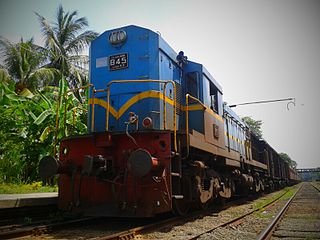
Sri Lanka Railways Class M8 is a class of Sri Lankan diesel-electric locomotive that was developed by Banaras Locomotive Works at Varanasi, India, in 1996. This class of locomotives was fitted with 2,800 hp (2,100 kW) V16 power units. This is used on both passenger and freight trains on Sri Lanka Railways. Currently this is the most powerful locomotive in Sri Lanka.

Class S12 is a diesel multiple-unit (DMU), built for Sri Lanka Railways by China's CSR Corporation. The first batch arrived in Sri Lanka in August 2012. They were built to replace locomotive-hauled passenger trains. Seven of the S12 DMUs were ordered to strengthen long-distance travel on the Main line from Colombo to Badulla. Four of S12s will serve the Kelani Valley Line. The remaining two designed as luxury trains.
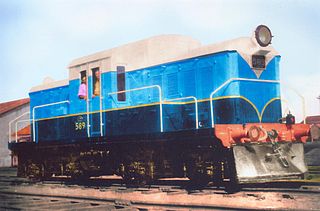
In 1955 the state owned Ceylon Government Railway, now the Sri Lanka Railways, manufactured Sri Lanka's "first" diesel-electric locomotive using old spares of withdrawn Class S1 DMU power sets. This locomotive was named as "Jayanthi" and classified Class M3 - 589. The locomotive was put to service on 5 September 1956. Two years later, in 1958, the then Ceylon Government Railway manufactured another locomotive and Classified it as Class M3 590.
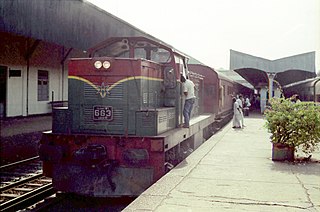
The Sri Lanka Railways Class W1 is a class of Sri Lankan diesel hydraulic locomotive that was built by Rheinstahl Henschel in 1969. A total of 45 W1s were built and imported. This is the first diesel-hydraulic locomotive which ran on Sri Lankan rail.

The Sri Lanka Railways Class S5 is a diesel multiple unit (DMU) built by Hitachi and introduced to Sri Lanka between 1969 and 1970, only two of which were imported. The class was built with modern interior facilities aiming towards the special train tours market.
Pettah Power Station was a thermal power station in Colombo in south western Ceylon.
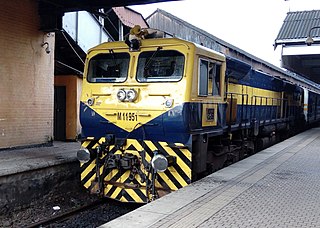
Class M11 is a mainline diesel-electric locomotive built by Banaras Locomotive Works, India, for use on Sri Lanka Railways and first delivered in 2018. This locomotive, clearly with its look, was developed from the WDG-4D locomotive of the Indian Railways, which is originally of 4,500 HP, as it uses a 16-cylinder variant of the EMD 710 prime mover. The HP was Down-tweaked to 3,000 using a 12-cylinder variant of the same engine, making it look and sound similar to British/European Railways' popular Class 66 EMD locomotive, but with AC-AC traction.
References
- 1 2 3 "Suburban Diesel Push-Pull types". Model Railroad Club of Sri Lanka. Retrieved 20 August 2014.
- 1 2 3 4 5 Nalin Abesinghe (April 2012). "Class S1 Self-propelled Articulated Power Coach" [ශ්රී ලකාවේ මුල්ම බලවේග දුම්රිය]. Lanka Railway Digest (in Sinhala). Sri Lanka. 1 (1): 16. ISSN 2279-1213.
- 1 2 3 4 "Class S1". Sri Lanka Railways Info Page. Retrieved 20 August 2014.
